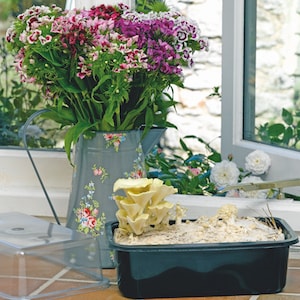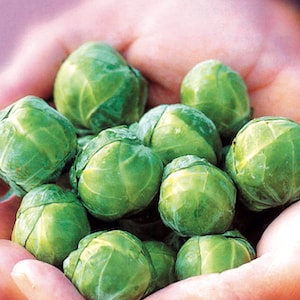What to do in your allotment in December
Written by Lee Senior
December is one of the quietest months of the allotment calendar. It’s a good time to reflect on what worked this year and perhaps on what didn’t, and to browse the exciting range of new vegetable seeds for next year.
As ever there are plenty of tasks for those keen enough to brave the inclement weather.
Our tools, both hand and powered, take a lot of the strain on our plots. This month is an ideal opportunity for cleaning and maintaining them, or arranging a service if required.
Within the relative sanctuary of the polytunnel and greenhouse there’s plenty of cleaning to do. Scrub your pots, staging, greenhouse glass or the outer skin of the polytunnel to remove any green algae or dirt. This will increase light levels and help to deter pests and diseases.
It’s a similar story outside; barbecues, paths, terracing and guttering are often in need of a clean now. Bio Washing Powder is a powerful cleaner that can be used in watering cans as an eco-friendly way to clean areas such as this. May I wish everyone a Happy Christmas and Peaceful New Year.
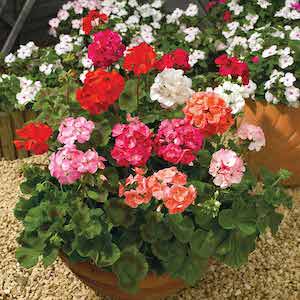
Image: Geranium F2 – Super Hybrid Mix
Allotment flowers in December
- Scatter hardy flower seeds that are about to go out of date around the plot. They’ll germinate in spring and surprise you with their random colour.
- Sow Geranium F2 ‘Super Hybrid Mix’ seeds under glass. They need a long season to give their best and, if you can provide frost-free conditions, they can be sown now. A minimum temperature of 18C is needed to ensure germination. Geraniums work well in mixed beds interspersed with vegetables.
- I sow sweet pea seeds on a warm windowsill in December for growing on in my cold greenhouse.
- Despite the recent cold snap, there are still a few straggly and tired roses trying to bloom. They will benefit from a winter prune (depending on the variety).
- Provided the soil isn’t waterlogged, winter is a great time to establish a new hedge. Thorny shrubs such as pyracantha or rosa rugosa form a living security hedge which, when established, can deter thefts.
- Cornus sanguinea ‘Winter Flame’ is a stunning dogwood that comes into its own at this time of year. If you have any drab corners, the bright flame-coloured stems are a great way to brighten things up.
- There’s still time, in early December, to plant tulip bulbs for flowering during late spring in any unused areas on or around your plot.
Allotment vegetables in December
- Your windowsill is a great place to grow fresh greens like pea shoots, herbs and microgreens during the colder months. Mushroom kits can be a great way to get an indoor winter crop, too. They also make a great Christmas gift!
- A thriving allotment can produce an impressive range of vegetables for Christmas lunch! Last year I contributed homegrown cabbage, cauliflower, garlic, Jerusalem artichokes, leeks, onions, parsnips, potatoes, swede and of course the inevitable sprouts. Christmas Day sprouts are the only sprouts my eldest daughter will eat all year!
- Wild Rocket Dragons Tongue can be sown all year round and this cut-and-come-again crop can be very successful from winter sowings. Grow on a bright windowsill (without too much direct heat from a radiator) and your rocket will be ready to harvest within 4-6 weeks.
- Continue to make successional sowings of overwintering broad beans either in a cold greenhouse or cold frame. ‘Aquadulce Claudia’ is one of my favourite varieties and it hasn’t let me down in 10 years. Try ‘Luz de Otono’ for beds and ‘The Sutton’ for containers.
- Make sure that all brassicas have a net over them to protect them from attack by pigeons.
- Start off your exhibition onion seeds using a heated propagator to speed up germination. Show varieties need a long growing season to swell to huge proportions.
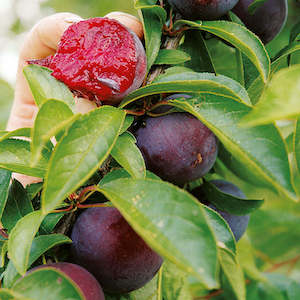
Image: Plum Tree – Beauty
Allotment fruit in December
- Create a new strawberry bed this month. Buy bare root plants now or use rooted runners from your own plants.
- Plant bare root plum and damson trees, adding plenty of mulch made from rotted manure or organic matter.
- There’s still time to divide large clumps of rhubarb and replant, or give some away to gardening friends or fellow plot holders.
- The dormant winter period is ideal for tackling old and neglected fruit trees that you may have inherited when taking on a new plot. Winter prune your apple and pear trees by removing dead branches and crossing growth. The aim is to open up the centre to create a good airflow.
- Avoid the temptation to prune plum trees over winter. This will encourage the destructive and damaging silver leaf disease.
- Gooseberries and currant bushes can also be pruned in winter as required.
- Cut back autumn-fruiting raspberries to ground level.
- Fruit cages come in different shapes and sizes and you can even build your own. They’re very useful, and this is the ideal time to purchase one, especially if you’re planning a new fruit garden on your plot.
Crops to harvest in December
- If you’ve grown potatoes for Christmas, harvest them as soon as possible unless they’re in pots or under cover.
- Your autumn and winter cabbages should be ready to harvest this month.
- Brussels sprouts, leeks, Jerusalem artichokes and swedes should be ready to harvest too.
- Keep picking kale.
- Harvest your late season potatoes and remember to save a few for Christmas dinner!
- Pull parsnips as you need them – they should be lovely and sweet now!
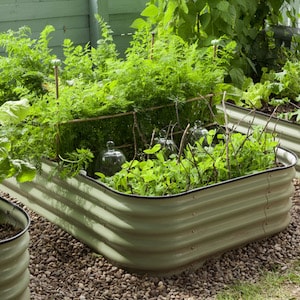
Image: Original Veggie Bed
General December allotment jobs
- Keep off beds this month to avoid compacting the ground when it’s wet. Use planks to spread your weight if you need to access beds.
- Take hardwood cuttings to propagate woody perennials like roses or herbs like rosemary. Cut a finger-long length of stem just below a pair of buds. Bury the cutting up to two thirds of its height in a pot to root.
- December is a great time to do big jobs like maintaining or installing paths, building raised beds and changing your plot layout.
- If you’re looking for an allotment hedging plant, Pyracantha ‘Red Star’ is a great choice. With bright red berries that last well into winter, this variety has less thorns than some and is great for the birds.
- Dig over your soil on a dry day. This improves the structure and allows larger clods to break down in winter frost. Remove any roots and rocks that you find in the soil.
- Check your shed and greenhouse. Look out for damage, clean the windows and tidy the inside. Apply a wood preservative while there’s no greenery in the way.
- Look after your tools this month. Sharpen and oil secateurs to keep the metal healthy and rust at bay.
- If you’ve taken on a new plot, focus on carefully planning the space. Start with where you want your shed, compost bins, and long term crops like asparagus and fruit trees to go.
- It’s not too late to gather up fallen leaves and store them in a wire rack or strong bin liner on your plot. Leafmould is a wonderful ‘free’ soil improver that helps to retain moisture.
Planning ahead
- Place your seed order for the coming year to make sure you get exactly what you want before stocks become low.
- Family asking you for Christmas present ideas? A heated propagator and some seeds from your newly made wish-list might fill your stocking rather nicely!
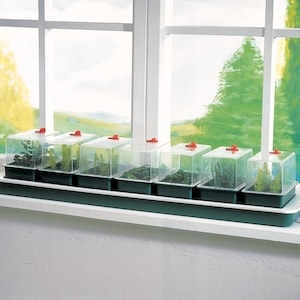
Image: Super 7 Electric Propagator
Suttons Seeds recommend these areas which may also be of interest.
- Previous month: What to do in your allotment in November
- Next month: What to do in your allotment in January


